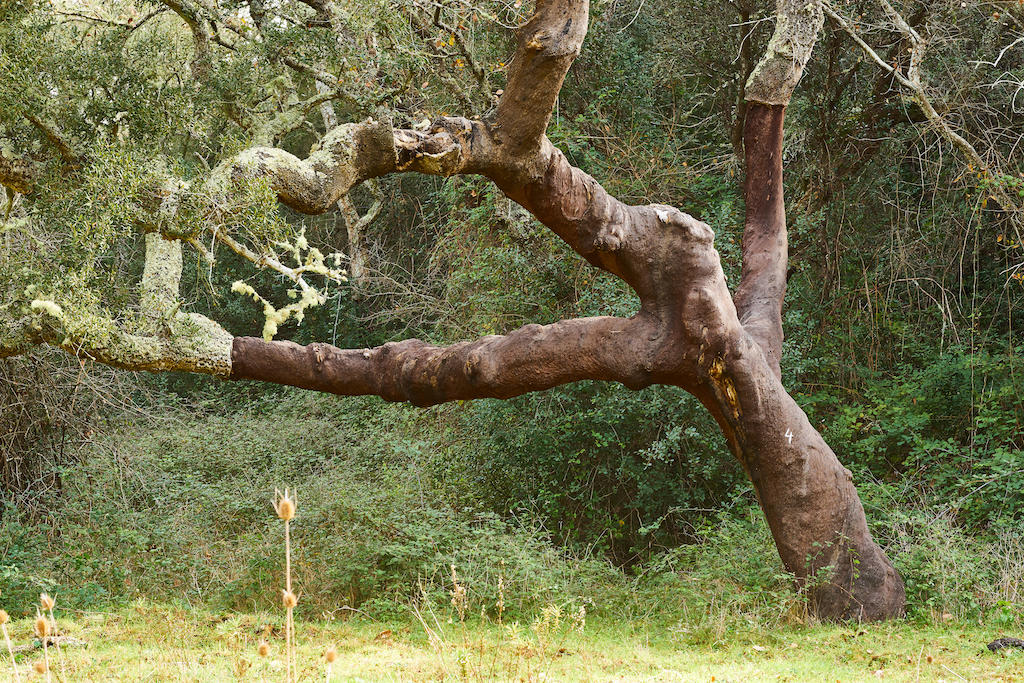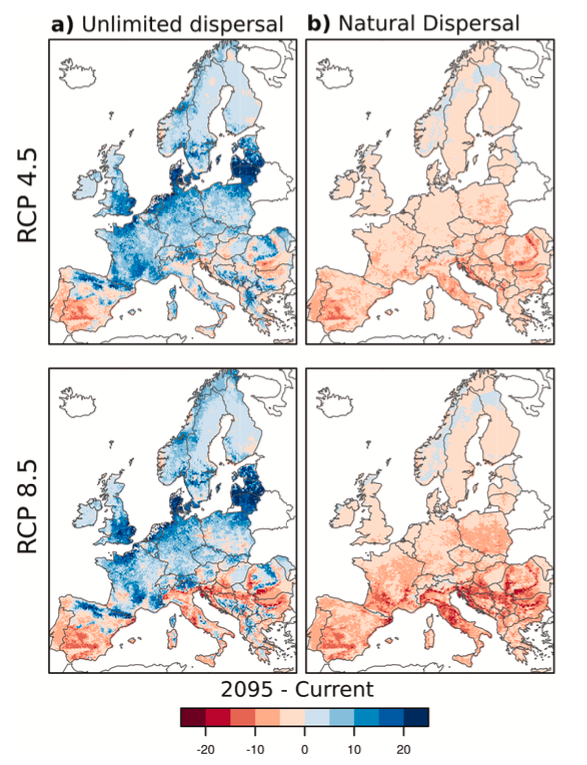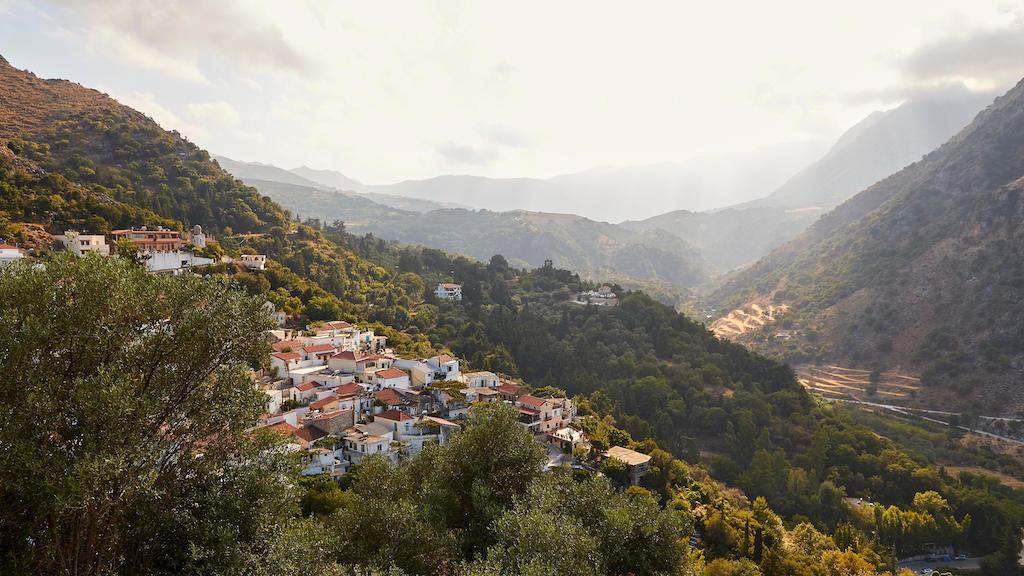There will be a significant loss in the benefits that European forests provide for humans and nature this century, concludes new research.
However, it also finds that these losses can be reduced – but not entirely stopped – by more strategic tree-planting.
The study says that “ecosystem services” supplied by forests, such as protecting soils or providing food, will reduce by 15% on average by the end of this century under a moderate-emissions scenario.
These losses can be partly mitigated if more consideration is given to the type of trees planted across the continent, the study finds.
However, the research, published in Global Environmental Change, says the Mediterranean will still see high losses of key benefits as conditions become more arid this century – even with the new strategies assessed in the study.
A researcher who was not involved in the study tells Carbon Brief that the findings resonate with other research showing that “forests, especially in the Mediterranean area, are being quite severely affected by changes in weather patterns”.
‘Decrease in forest production’
Forests provide a wide range of benefits to humans and the environment. Some of these are direct, such as wood for fuel and construction. Others are indirect, such as protecting soils from erosion.
A 2020 report from the EU’s Joint Research Centre says that forests are the bloc’s largest land ecosystem. They harbour biodiversity and contribute “significantly” to climate change mitigation, the report adds.
Around 10% of the EU’s annual greenhouse gas emissions are absorbed and stored in forest soils and trees, according to the European Environment Agency.
But climate change has already made forests in Europe more vulnerable, according to a 2021 Nature Communications study. It found that carbon sequestration, biodiversity conservation and other key services could be “seriously compromised” in future due to the impacts of climate change.
And heat extremes and floods will become more frequent in Europe over the coming decades, with a range of impacts on forest services, according to the Intergovernmental Panel on Climate Change (IPCC).
The new study examines three forest-management strategies aimed at reducing or reversing the loss of benefits that forests provide.
The first strategy samples random species to replace those lost. The second chooses replacements that maximise one specific ecosystem service, such as soil protection. The third strategy identifies the species offering the best overall outcome for all of the services.
The researchers used species-distribution maps from a dataset they previously developed called EU-Trees4F. This holds current and future potential distributions of 66 tree species in Europe under different emissions pathways and species dispersal possibilities. These species range from horse-chestnut and common ash trees, through to pine and sycamore maple.
The future outlooks assess the spread of species under one scenario where the trees disperse by themselves naturally and another where they are aided by humans to spread out to more areas where they are suited to the climate.
Each strategy is assessed under two future emissions pathways: a moderate-emissions scenario (RCP4.5) and a very-high-emissions scenario (RCP8.5).

The researchers modelled different “optimal” combinations of tree species in a forest to maximise the benefits they can provide.
In each scenario, the researchers find that replacing locally lost tree species with ones better-suited to future climate conditions can reduce the decline of ecosystem services, compared to scenarios with no such “assisted migration”.
Benefits to humans
The researchers look at seven services for each tree species: construction; cultural (such as species in areas used for recreation or spiritual purposes); food; fuelwood; medicine, pulpwood paper; and soil protection.
Other services, such as carbon sequestration, were not examined, as the researchers say there was a lack of consistent data available for all the tree species in the study.
They note that there are “unavoidable trade-offs” when trying to optimise all of the different benefits.
Dr Achille Mauri, the lead author on the study and a postdoctoral researcher at the University of Helsinki, notes that there is risk in selecting species that mostly benefit a single service, such as producing wood, and possibly “neglect[ing] other ecosystem services, such as biodiversity”.
The study estimates that under a moderate-emissions scenario, the services provided by forests will decrease by 15% on average in Europe by the end of this century, without human intervention. This decrease could reach up to 52% in the Mediterranean under the same future pathway.
With the help of tree migration strategies – moving species of trees to an area where they may not have been grown before – these losses could reduce to 10% on average, the study says.
However, it finds that ecosystem services will still reduce by approximately one-third in the Mediterranean region by the end of this century, even with human intervention.
The map below shows the changes in tree species abundance by the end of this century compared to their current level. Results are shown for both RCP4.5 (top) and RCP8.5 (bottom) emissions pathways.

Mediterranean impacts
Higher temperatures and lower rainfall will make the Mediterranean more arid in future, according to the IPCC. Warming of 2C or more will also drive an increase in droughts and fires across the region, which spans all of Greece, Malta and Cyprus and parts of France, Portugal, Italy and Spain.
The study finds that this region will see fewer benefits from assisted tree migration in the years ahead compared to other parts of Europe.
Mauri says these “worrying” findings may be too pessimistic, as the study only includes European tree species. Bringing tree species from northern Africa, which has a similar climate, to the Mediterranean may be a solution. But he notes that introducing new species can have “important consequences” and cause possible problems.
Some species already grow in parts of the Mediterranean and northern Africa, such as cork oak and juniperus thurifera.
Prof John Mackay, a forest geneticist at the University of Oxford, tells Carbon Brief that bringing tree types in from other areas “is a reasonable solution” in certain circumstances. He adds:
“There are caveats with bringing in exotics because they are generally expected to be less well-adapted to other organisms that occur in the ecosystem.
“The truth is, Europe is already laced with exotics. It’s not a new thing…It has to be done carefully, but I think it can help. Losing the ecosystem services can be quite impactful. For example, you can end up with a lot of soil erosion happening and that has knock-on effects.
“It’s the sort of thing that might become necessary in the future. There’s always a compromise. But if you’re able to maintain the forest, I think some compromises are acceptable.”
Future ‘extreme’ conditions
Mauri says a reduction in ecosystem services in forests causes “fundamental problems”. He tells Carbon Brief:
“There will be a substantial decrease in forest production and the forest ecosystems, such as the wood that is used as a construction material.”
It will have other effects on species, wildlife and biodiversity, he adds, alongside “future decreasing forest productivity”.
Mackay says that this study aligns with other research, which has found “that forests, especially in the Mediterranean area, are being quite severely affected by changes in weather patterns, including severe weather events”. He adds:
“Normally, tree species adapt to the climate and general conditions they grow in. It’s a slow evolutionary process that can involve some natural migration. But trees are among the slowest species to migrate. They can’t move, obviously, like animals would. Their seeds and their pollen can be disseminated, but it remains a slow process. So through assisted migration, we can speed that up.”

The authors write that assisted tree migration can play a “critical role” in maintaining forest ecosystem services in future.
The study concludes that its framework “may serve as a scientifically sound base for decision-making” and can help inform EU environmental and biodiversity plans, such as the EU’s pledge to plant 3bn trees on the continent by 2030.
A key significance of the findings, the study notes, is that the strategies reduce ecosystem service losses under both moderate and high-emission future pathways. This means the solutions are effective regardless of how much emissions rise, it adds.
Mauri says that the findings can help forest managers to “decide what kind of tree species can be planted in the future”.
Although introducing a certain species of tree that is better adapted to warmer conditions may increase their resilience, Mackay warns that there is a limit. He tells Carbon Brief:
“When conditions become extreme, that evolutionary change is just not enough to compensate.
“This is really important because, unfortunately, there’s this idea that ‘oh, trees are just going to save us from climate change, we just need to plant more trees to soak up more carbon’. This is where it runs into problems. The trees themselves are being affected by the changes, so they won’t have that capacity to make a massive change in the future.”
Mauri et al. (2023), Assisted tree migration can reduce but not avert the decline of forest ecosystem services in Europe, Global Environmental Change, doi:10.1016/j.gloenvcha.2023.102676
Sharelines from this story
- SEO Powered Content & PR Distribution. Get Amplified Today.
- PlatoAiStream. Web3 Data Intelligence. Knowledge Amplified. Access Here.
- Minting the Future w Adryenn Ashley. Access Here.
- Buy and Sell Shares in PRE-IPO Companies with PREIPO®. Access Here.
- Source: https://www.carbonbrief.org/helping-climate-compatible-trees-spread-their-seeds-may-benefit-europes-forests/



